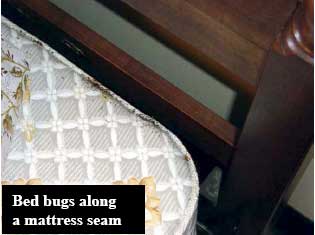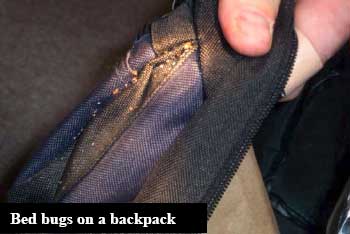Bedbugs: How to Avoid Them & What to Do if You’re Bitten
by BootsnAll
 It’s one of those old-fashioned sayings you’ve heard over and over, but probably never really stopped to consider the meaning of; perhaps your mother even said it to you as she tucked you into bed: “Sleep tight, don’t let the bedbugs bite!” It’s cute. It rhymes. How could it refer to anything even remotely malevolent? And yet…
It’s one of those old-fashioned sayings you’ve heard over and over, but probably never really stopped to consider the meaning of; perhaps your mother even said it to you as she tucked you into bed: “Sleep tight, don’t let the bedbugs bite!” It’s cute. It rhymes. How could it refer to anything even remotely malevolent? And yet…
While you may not have to think about being bitten by teeny insects when you’re fast asleep in your bed at home, you’d better at least make yourself aware of what bedbugs are – and learn how to deal with them – if you’re going to be traveling. Because even if you can’t see them, that doesn’t mean they’re not there.
(Are you itchy yet? Cuz I am.)
Bedbugs are, to get technical, a tiny nocturnal insect that lives off of the blood of warm-blooded creatures – including humans. They come out of their hiding places during the night and early dawn and bite their dozing victims, usually for about five minutes until they’re full. You’ll know you’ve been bitten if you wake up and find little spots of blood on the sheets or small bumps on your skin that form orderly rows (often in groups of three).
You might have already known all of that, but what you might not know is that bedbugs, unlike roaches, are not associated with unsanitary conditions. In other words, the cleanliness of a hotel or hostel doesn’t have any direct bearing on whether you’ll find bedbugs there. Certainly, thorough and regular cleaning (especially of mattresses, blankets, and other soft materials) will go a long way in keeping an infestation of bedbugs from getting a foothold in the first place, but bedbugs can be transferred from place to place on the clothing of the travelers who are staying in those hotels and hostels, so even places that are cleaned regularly could be hosting a few unwanted critters.
Detecting Bedbugs Before Bedtime
 If you have any reason to believe that the hotel or hostel room you’re looking at staying in has bedbugs, there are a few areas you can check for before it’s lights out. Because bedbugs typically hang out in clusters when they’re not feeding, you stand a decent chance of finding some if there’s an infestation.
If you have any reason to believe that the hotel or hostel room you’re looking at staying in has bedbugs, there are a few areas you can check for before it’s lights out. Because bedbugs typically hang out in clusters when they’re not feeding, you stand a decent chance of finding some if there’s an infestation.
- Look at the seams of mattresses, box springs and pillows. If you find what looks like a dark stain, look more closely.
- Check any areas where you’re going to be putting your bags and clothes in addition to where you’re going to sleep, including chairs, desks, and closets.
- The waste bedbugs produce is extremely dark in color, since it’s digested blood, so if you see dark stains on the sheets, that’s cause for further questioning.
(Seriously, this article can be done at any time now. Can’t stop itching.)
What to Do if You’re Bitten by Bedbugs
 Even the cleanest and most cautious traveler can still get bitten by bedbugs, so it’s good to know what to do if you find that you’ve been a bug’s buffet during the night.
Even the cleanest and most cautious traveler can still get bitten by bedbugs, so it’s good to know what to do if you find that you’ve been a bug’s buffet during the night.
- Despite what you might think, bedbug bites aren’t known to transmit diseases. The worst they do is make you itch where they bite, which is an allergic reaction to the anti-coagulants they inject into the victim as they’re feeding.
- Before you pack your stuff and move to your next location, you’ll need to wash all of your clothing in at least 120°F water to make sure any bedbugs hiding in the fabric are killed. You don’t want to be the ride they hitch to the next hotel.
- If you can’t wash something in 120°F water, another option is to put items in a clothes dryer set on medium to high heat for at least 10 minutes (20 minutes is better).
- Don’t send your clothes for dry-cleaning without taking steps to kill the bugs yourself first, because that could just spread them to the dry-cleaning establishment.
- Another method to kill the bedbugs (or potential bedbugs) in your stuff is to put your belongings in a plastic bag and putting the bag outside in a location where it’s going to get hot and sunny (rooftop terrace, closed vehicle), and leave the bag there for a day. The fewer items in the bag the better, so as to eliminate any cooler spots for bugs to hide from the heat. The internal temperature of the bag needs to reach 120°F in order for this method to work.
- Although the bites you’ll get from bedbugs may itch, if you can avoid scratching them too much that’s good, because you risk infection if you break the skin. The itching can last several days at worst.
- Some people find temporary relief from the itch by applying hot water to the affected areas. If the water isn’t hot enough, however, it could make the itch worse – so this could actually backfire if you can’t tolerate the heat required to dull the itch and don’t want to risk burning your skin.
- While corticosteroids taken as pills generally don’t have much of an impact on the itching, topically applied corticosteroids (such as hydrocortisone) do help some people by speeding the healing process and decreasing the level of itching.
Now if you, unlike me, want to actually keep reading more about bedbugs, there’s plenty of information online. This document gives more tips on how to prevent becoming a transport device for bedbugs, and Wikipedia has more links and info that’ll make your skin crawl.
original photos by, top to bottom: A.L. Szalanski and University of Minnesota (photos 2 & 3).